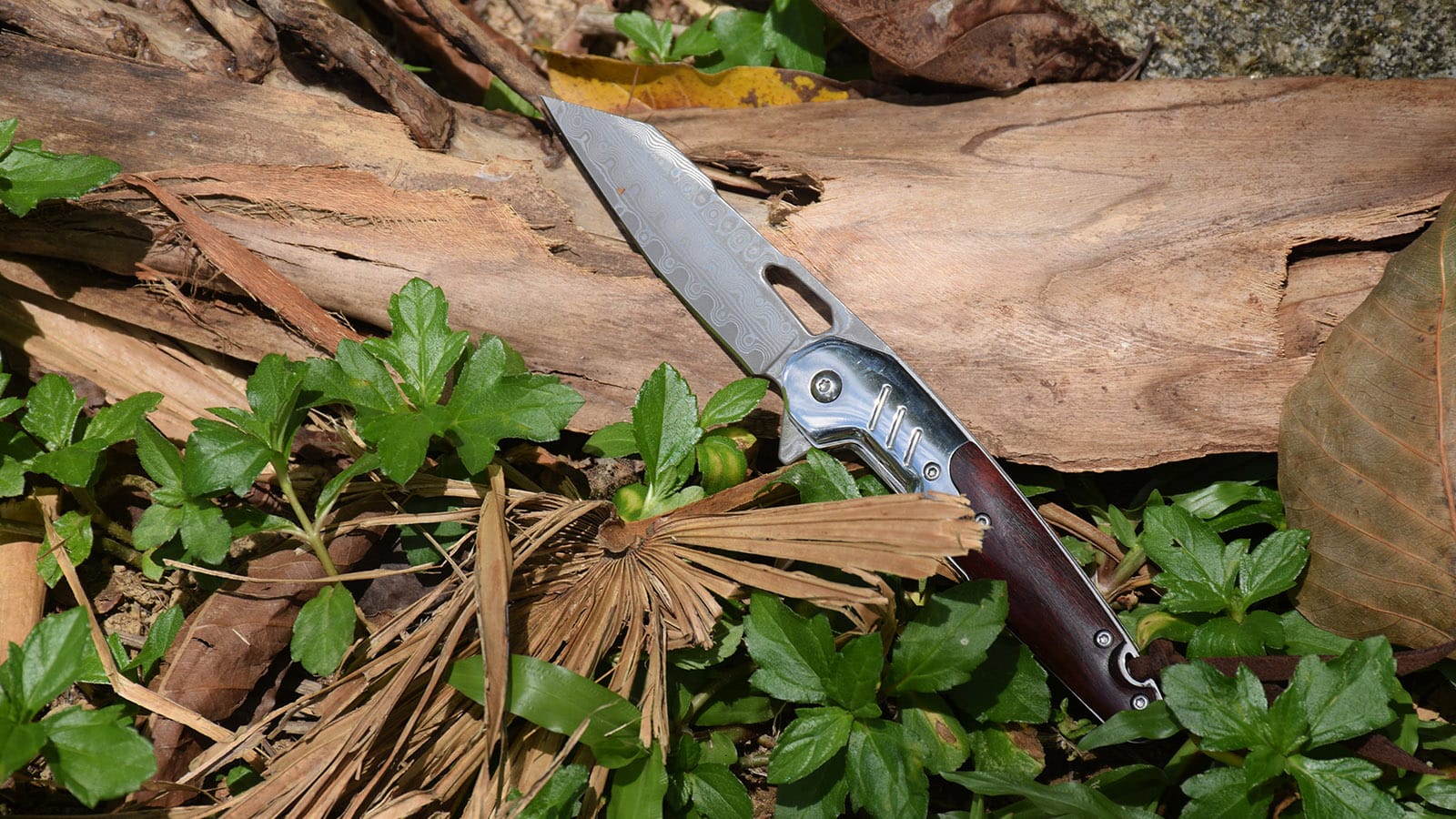Дамаська сталь давно захоплює любителів ножів своїми чарівними візерунками та легендарною репутацією. Але чи справді це найкращий варіант для вас кишеньковий ніж? Цей вичерпний посібник дослідить переваги та недоліки дамаської сталі, її історію та її порівняння з іншими популярними матеріалами для ножів. Незалежно від того, чи ви завзятий любитель відпочинку на природі, колекціонер чи просто той, хто цінує якісне лезо EDC, ця стаття допоможе вам прийняти зважене рішення щодо наступної покупки кишенькового ножа.
Що таке дамаська сталь?
Дамаська сталь — це тип сталі, відомий своїми характерними хвилястими візерунками на поверхні леза. Ці візерунки, які часто називають «водяними знаками» або «дамаськими візерунками», створюються шляхом накладання шарів різних типів сталі та їх ковальського зварювання. Результатом є лезо, яке не тільки виглядає приголомшливо, але й поєднує в собі властивості різних сталей, використаних у його конструкції. Сучасну дамаську сталь зазвичай виготовляють за допомогою технології, що називається зварюванням за малюнком, яка передбачає згортання та зварювання шарів різних сталевих сплавів. Цей процес створює лезо з унікальним поєднанням твердості, гнучкості та збереження краю.
Історія дамаської сталі: від давніх часів до сучасності
Історія дамаської сталі така ж захоплююча, як і самі леза. Вважається, що термін «дамаск» походить від міста Дамаск у Сирії, де продавалися ці леза. Однак справжнє походження цієї сталі може сягати Індії, де вироблявся тип високовуглецевої сталі під назвою сталь Вуца. Стародавня дамаська сталь, також відома як дамаск Вуца або справжній дамаск, славилася своєю винятковою міцністю та гострим краєм. . Легенди розповідали про леза, які могли прорізати стволи рушниць і залишатися достатньо гострими, щоб розрізати падаючий шовковий шарф. На жаль, точний метод створення цієї легендарної сталі був втрачений в історії. Сучасна дамаська сталь, хоча й не така сама, як стародавня сталь Вуца, намагається відтворити зовнішній вигляд і деякі властивості оригіналу. Сучасна дамаська сталь виготовляється з використанням техніки зварювання за малюнком, поєднуючи різні типи сталі для створення візуально вражаючих і високоефективних лез.
Як виготовляється сучасна дамаська сталь?
Процес створення сучасної дамаської сталі є свідченням майстерності та майстерності майстрів. Ось спрощений огляд необхідних кроків:
- Вибір сталей: Майстер обирає два чи більше типів сталі з різними властивостями. Загальний вибір включає високовуглецеві сталі, такі як 1095 і 15n20.
- Багатошаровість: Відібрані сталі складаються шарами, що чергуються.
- Ковальське зварювання: стопка нагрівається до надзвичайно високих температур і забивається молотком, щоб сплавити шари разом.
- Складні: Отриману заготовку згинають і знову зварюють ковальським способом, збільшуючи кількість шарів.
- Повторення: кроки 3 і 4 повторюються кілька разів, що часто призводить до сотень або навіть тисяч шарів.
- Формування: Дамаська заготовка надається у бажану форму ножа.
- Офорт: Лезо протравлено кислотою, щоб виявити характерний дамаський малюнок.
Цей процес створює лезо, яке не тільки має унікальний зовнішній вигляд, але й поєднує в собі властивості різних сталей, використаних у його конструкції.
Які переваги кишенькових ножів з дамаської сталі?
Кишенькові ножі з дамаської сталі пропонують кілька переваг, які роблять їх привабливими як для колекціонерів, так і для повсякденних перевізників:
- Унікальна естетика: Хвилясті візерунки на дамаських лезах візуально вражають і роблять кожен ніж витвором мистецтва.
- Збалансована продуктивність: Завдяки поєднанню різних типів сталі дамаські леза можуть запропонувати гарний баланс між твердістю, міцністю та збереженням краю.
- Потенціал для налаштування: Досвідчені різаки можуть маніпулювати візерунком з дамаску та поєднанням сталі, щоб створювати ножі відповідно до конкретних потреб.
- Початок розмови: Кишеньковий ніж з дамаської сталі обов’язково приверне увагу та розпалює цікаві дискусії.
- Потенціал відмінного утримання країв: Залежно від використовуваної сталі та процесу термічної обробки дамаські ножі можуть довго тримати лезо.

Прекрасний зразок складного ножа з дамаської сталі з дерев'яною ручкою
Чи є якісь недоліки у кишенькових ножів з дамаської сталі?
Хоча кишенькові ножі з дамаської сталі мають багато переваг, важливо враховувати деякі можливі недоліки:
- Вища вартість: Складний виробничий процес і необхідна кваліфікована робоча сила роблять ножі з дамаської сталі загалом дорожчими, ніж їхні аналоги зі звичайної сталі.
- Технічне обслуговування: Деякі леза з дамаської сталі потребують більш ретельного догляду, щоб запобігти іржі та зберегти малюнок.
- Мінливість якості: Ефективність ножа з дамаської сталі може значно відрізнятися залежно від конкретної сталі, що використовується, і майстерності коваля.
- Не обов’язково чудова продуктивність: хоча дамаська сталь може працювати чудово, вона за своєю суттю не перевершує високоякісні моносталеві леза щодо ефективності різання.
- Можливість підробок: Популярність дамаської сталі призвела до того, що деякі виробники виготовляють підроблені дамаські візерунки за допомогою травлення або іншої обробки поверхні.
Дамаська сталь проти нержавіючої сталі: що краще для кишенькових ножів?
При порівнянні дамаська сталь до нержавіючої сталі для кишенькових ножів, слід враховувати кілька факторів:
| Дамаська сталь | Нержавіюча сталь |
|---|---|
| Унікальний зовнішній вигляд | Однорідний зовнішній вигляд |
| Може поєднувати властивості кількох сталей | Послідовні властивості в усьому |
| Може потребувати додаткового обслуговування | Загалом простіше в обслуговуванні |
| Часто дорожче | Зазвичай доступніше |
| Може мати відмінне утримання країв | Гарне утримання кромок у високоякісних нержавіючих сталях |
| Може бути більш схильним до іржі (залежно від використовуваної сталі) | Висока стійкість до іржі та корозії |
Зрештою, вибір між дамаском і нержавіючої сталлю зводиться до особистих уподобань, бюджету та призначення. Високоякісний ніж з нержавіючої сталі може працювати так само добре, як і ніж з дамаської сталі для повсякденного носіння, при цьому він простіший в обслуговуванні та доступніший.
Як дамаська сталь порівнюється з вуглецевою сталлю?
Вуглецева сталь є ще одним популярним вибором для кишенькових ножів, особливо серед ентузіастів, які віддають перевагу утриманню краю та легкості заточування. Ось як дамаська сталь відрізняється від вуглецевої сталі:
- Утримання краю: як дамаська, так і вуглецева сталь можуть запропонувати відмінне утримання кромок, залежно від конкретної сталі, що використовується, і термічної обробки.
- Заточка: Вуглецеву сталь, як правило, легше заточити, ніж більшість лез з дамаської сталі.
- Технічне обслуговування: Вуглецева сталь вимагає регулярного обслуговування для запобігання іржі, подібно до деяких дамаських сталей.
- Зовнішній вигляд: Дамаська сталь має унікальні візерунки, тоді як вуглецева сталь з часом утворює патину.
- Вартість: Високоякісні ножі з вуглецевої сталі зазвичай дешевші, ніж аналогічні ножі з дамаської сталі.
- Продуктивність: Обидва можуть запропонувати чудову продуктивність різання, причому вуглецева сталь часто віддається перевагою через її здатність приймати та утримувати дуже гострий край.
Чи варто дамаська сталь ціни на кишеньковий ніж?
Вартість кишенькового ножа з дамаської сталі залежить від ваших пріоритетів і бюджету. Якщо ви цінуєте естетику дамаського візерунка та любите володіти унікальними виробами ручної роботи, ніж з дамаської сталі може стати гідною інвестицією. Однак, якщо ваша головна турбота полягає в зниженні продуктивності, а у вас обмежений бюджет, ви можете виявити, що високоякісний ніж із нержавіючої або вуглецевої сталі пропонує краще співвідношення ціни та якості. Коли покупка кишенькового ножа з дамаської сталі, врахуйте наступне:
- Репутація виробника або майстрів
- Види сталі, що використовуються в дамаській конструкції
- Загальна посадка та обробка ножа
- Відгуки покупців та експертизи
- Цільове використання ножа (наприклад, EDC, кемпінг, колекціонування)
Як доглядати за кишеньковим ножем із дамаської сталі
Належний догляд необхідний для збереження краси та продуктивності вашого кишенькового ножа з дамаської сталі. Ось декілька порад:
- Тримайте його в чистоті: Після використання протріть лезо м’якою тканиною. Якщо необхідно, використовуйте м’яке мило та воду, а потім ретельно висушіть.
- Змастіть лезо маслом: Час від часу наносите тонкий шар харчової мінеральної олії, щоб захистити лезо від вологи.
- Правильно зберігати: Зберігайте ніж у сухому місці, бажано в захисних піхвах або сумці.
- Уникайте вологи: Не зберігайте ніж із дамаської сталі у вологому середовищі та не залишайте його мокрим протягом тривалого часу.
- Обережно заточуйте: Під час заточування використовуйте методи, які відповідають конкретній сталі вашого дамаського леза.
- Будьте уважні до використання: Незважаючи на те, що дамаська сталь може бути міцною, уникайте її використання для важких завдань, які можуть сколоти або пошкодити лезо.
Де можна знайти високоякісні кишенькові ножі з дамаської сталі?
Якщо ви зацікавлені в покупці кишенькового ножа з дамаської сталі, розгляньте наступні варіанти:
- Роздрібні торговці спеціальними ножами: Магазини, що спеціалізуються на високоякісних ножах, часто пропонують вибір кишенькових ножів з дамаської сталі.
- Кузні на замовлення: багато досвідчених майстрів виготовляють ножі з дамаської сталі на замовлення.
- Інтернет-ринки: Веб-сайти, як Кишеньковий ніж HT пропонують різноманітні ножі з дамаської сталі, в т.ч складні ножі і варіанти з фіксованим лезом.
- Шоу та виставки ножів: Ці події можуть стати чудовим місцем, щоб побачити та придбати ножі з дамаської сталі від різних виробників.
- Магазини спорядження для активного відпочинку та EDC: Деякі магазини елітного спорядження для активного відпочинку продають кишенькові ножі з дамаської сталі.
Вибираючи кишеньковий ніж з дамаської сталі, обов’язково ознайомтеся з продавцем і конкретним ножем, щоб переконатися, що ви отримуєте справжній високоякісний продукт.
Ключові висновки
- Дамаська сталь пропонує унікальну естетику та може забезпечувати відмінні характеристики кишенькових ножів.
- Сучасну дамаську сталь створюють за допомогою зварювання за малюнком, поєднуючи різні типи сталі.
- Хоча ножі з дамаської сталі красиві, вони можуть вимагати більшого догляду, ніж ножі з нержавіючої сталі.
- Продуктивність ножа з дамаської сталі залежить від конкретної сталі, яка використовується, і майстерності коваля.
- Високоякісні ножі з нержавіючої або вуглецевої сталі можуть запропонувати аналогічну продуктивність за нижчою ціною.
- Належний догляд необхідний для збереження краси та ефективності кишенькового ножа з дамаської сталі.
- Купуючи ніж з дамаської сталі, ознайомтеся з продавцем і конкретним ножем, щоб переконатися в якості.
Підсумовуючи, кишенькові ножі з дамаської сталі можуть стати чудовим вибором для тих, хто цінує їх унікальну естетику та майстерність. Однак вони не обов’язково перевершують високоякісні моносталеві ножі з точки зору продуктивності. Чи підійде вам ніж з дамаської сталі, залежить від ваших особистих уподобань, бюджету та бажання обслуговувати лезо. Незалежно від вашого вибору, добре виготовлений кишеньковий ніж, за якого належним чином доглядають, буде цінним інструментом у вашому повсякденному носінні довгі роки.



